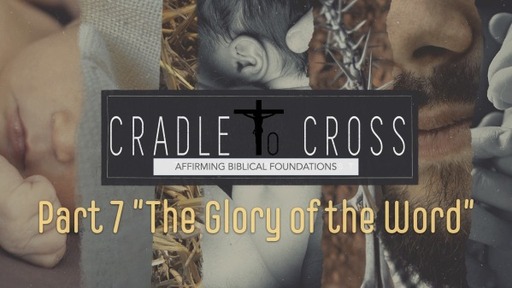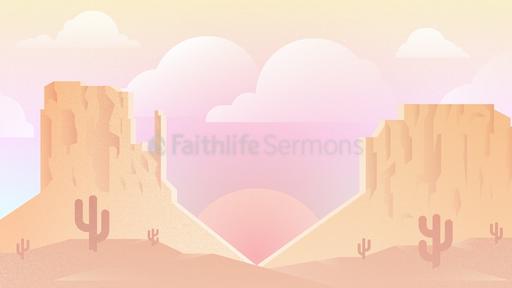The Glory of the Word

Notes
Transcript
1 And after six days Jesus taketh Peter, James, and John his brother, and bringeth them up into an high mountain apart, 2 And was transfigured before them: and his face did shine as the sun, and his raiment was white as the light. 3 And, behold, there appeared unto them Moses and Elias talking with him. 4 Then answered Peter, and said unto Jesus, Lord, it is good for us to be here: if thou wilt, let us make here three tabernacles; one for thee, and one for Moses, and one for Elias. 5 While he yet spake, behold, a bright cloud overshadowed them: and behold a voice out of the cloud, which said, This is my beloved Son, in whom I am well pleased; hear ye him. 6 And when the disciples heard it, they fell on their face, and were sore afraid. 7 And Jesus came and touched them, and said, Arise, and be not afraid. 8 And when they had lifted up their eyes, they saw no man, save Jesus only. 9 And as they came down from the mountain, Jesus charged them, saying, Tell the vision to no man, until the Son of man be risen again from the dead.
matt 17:8 “8 And when they had lifted up their eyes, they saw no man, save Jesus only.”
The transfiguration of Jesus, which receives so prominent a place in three of the Gospels, is not often spoken of in Christian teaching or expounded upon from the pulpit.
The great hymn writers have penned lines about many other events in the life and ministry of our Lord, yet the transfiguration is sung rarely about in congregations throughout the land.
Many popular theology textbooks, used in seminaries and colleges over the years, say little to nothing about this magnificent display of the divinity and power of Christ in those moments on the mountain top.
What is the reason for so many pastors, theologians, and authors avoiding delving into the detail of the transfiguration account?
The question must be asked is the reason Christ was transfigured in front of his closest disciples too hard to draw out of the account?
Surely not!
What then is the reason for the shroud of complexity around the events of the transfiguration?
A systematic approach to the events of the transfiguration will help form a conclusion as to why Christ allowed the disciples to see his transfiguration, and what the reader of scripture can draw from this glorious preview.
1. The Precursor to the Preview
1. The Precursor to the Preview
In the events leading up to the transfiguration Jesus had moved his disciples from the coasts of Magdala to Caesarea Phillipi.
The context of Matthew 17 is extremely important in understanding the transfiguration.
In Matthew 16 Jesus had asked the disciples about how the public and the disciples themselves perceived him; his public response had been that Jesus must be one of the great prophets of Israel returned
14 And they said, Some say that thou art John the Baptist: some, Elias; and others, Jeremias, or one of the prophets.
However, the disciples who had a more intimate knowledge of Jesus had begun to perceive that he was the promised Messiah.
In Jesus' work of training the disciples there were two basic phases; identification and understanding.
In the first part of Jesus' ministry the disciples accompanied him all over Galilee observing his power and listening to his teaching.
This program of teaching was to bring the disciples to identify Jesus correctly, not as just another prophet but as the Son of God.
The disciples reached this point in Matthew 16:16, with Peter's confession “Thou art the Christ, the Son of the living God” ( Matt 16:16).
The aim of the second phase of the training of the twelve was to teach the disciples what it meant to say that Jesus was the Son of God.
It is clear that the disciples of Jesus harboured the same kinds of Messianic hopes as most other Jews of their day. The disciples like most other Jews expected a militaristic figure who would lead Israel against her enemies and establish God's kingdom on earth, overthrowing the Roman occupation in the process.
The Jews expected a national revival and a period of blessing as in the days of old. Jesus knew that the disciples were harbouring the same expectations of him.
Immediately after Peter's break-through confession Jesus began to speak of his death at the hands of the scribes and the chief priests and the elders, and of his resurrection on the third day
21 From that time forth began Jesus to shew unto his disciples, how that he must go unto Jerusalem, and suffer many things of the elders and chief priests and scribes, and be killed, and be raised again the third day.
Jesus announces, for the first time in a direct way, his coming death and resurrection. Jesus, now acknowledged as Messiah, tells his disciples that he will, in effect, be the opposite of what they expected.
Following this Jesus goes on to speak of the need of all his disciples, therefore, to deny themselves, the need to take up their crosses daily and to be willing to lose their life for him.
Then come the words of Jesus
28 Verily I say unto you, There be some standing here, which shall not taste of death, till they see the Son of man coming in his kingdom.
here Jesus makes the promise that some of the people standing there would not taste death until they saw him coming in his Kingdom.
All of those who stood there that day are long in their graves and our Lord has not yet come.
It is of no small wonder that this statement from Jesus has caused so many to misunderstand the kingdom programme, for they wonder how the disciples saw the Lord coming in His kingdom.
In the chronology of the Life of Christ, the declaration that some of these men would see Jesus coming in his Kingdom is right after Peter’s declaration of Christ’s deity and just before the transfiguration itself.
This is an important timeline placement, and the crescendo of events leading up to the transfiguration should not be lost on the one who is trying to exegete the meaning and importance of the transfiguration itself.
moving on then from the backstory in the precursor to the preview, we move to the place of the preview
2. The Place of the Preview
2. The Place of the Preview
1 And after six days Jesus taketh Peter, James, and John his brother, and bringeth them up into an high mountain apart,
The early Church fathers believed that the transfiguration took place on Mt. Tabor, including Cyril of Jerusalem (in 348), Epiphanius, and Jerome, whereas Eusebius was uncertain if it took place on Mt. Tabor or on Mt. Hermon.
One possible reason for the identification of Mount Tabor was a misunderstanding of the wording of Matthew 17:1 which reads “And after six days Jesus taketh Peter, James, and John his brother, and bringeth them up into an high mountain apart”
The word apart in this verse was taken to mean that Jesus took the disciples up a mountain by itself, rather than simply that he took the disciples up a mountain by themselves.
Mt. Tabor is probably not the location for the transfiguration for a few simple reasons.
Firstly, Jesus and his disciples are, as we have determined from scripture in the region of Caesarea Philippi just prior to the transfiguration.
Secondly the general location of the mountain is not isolated as much traffic passed by through the Jezreel Valley below.
Thirdly, a Roman military fort was located on top of the mountain and was clearly in use during the Hasmonean period and the time of the Jewish Revolt, and likely would have been in Jesus' day as well.
Taking all the above points into consideration the most likely location for the transfiguration would indeed be Mount Hermon, but of course scripture does not specially say that for sure, so no complete surety of Mount Hermon is possible.
However, it does not do the account and true meaning of transfiguration any damage if either mountain is suggested as the true location for the event
we have the context, we have the place, now let’s look at the participants
3. The Participants of the Preview
3. The Participants of the Preview
1 And after six days Jesus taketh Peter, James, and John his brother, and bringeth them up into an high mountain apart,
3 And, behold, there appeared unto them Moses and Elias talking with him.
On several occasions Jesus took his inner circle of closest disciples aside for a special event or teaching. Scripture bears out that this group always included Peter, James, and John and sometimes Andrew was there as well.
The transfiguration was one of these events and Jesus leads Peter, James, and John up into a high mountain. As the scene unfolds Christ is transfigured before them, and as the three disciples watch in amazement, Moses and Elijah appear to them, shrouded in the Lord’s glory.
Peter, James, and John did not have any pictures of Elijah and Moses to reference so, it’s fair to say they had no idea what these two Old Testament saints even looked like; yet they instinctively knew they were in the presence of those two who so represented the law and the prophets.
Why, we may wonder, were these two men chosen out of many godly Old Testament believers who might have been chosen? Why, for instance, did God not present the great patriarch Abraham or King David the man after God’s own heart? Why was Isaiah, Jeremiah, Ezekiel or one of the other major prophets not chosen?
The answer it seems is that no other two represented the Law and Prophets better than Moses and Elijah.
Moses was a great Lawgiver, and Elijah was the great defender of the Law.
As no others, Moses and Elijah represented the Old Testament, the Law, and the prophets and by their presence together on that mountain, as John McArthur writes, they affirmed in effect:
“This is the One of whom we testified, the One in whose power we ministered, and the One in whom everything we said and did has meaning. Everything we spoke, accomplished, and hoped for is fulfilled in him.”
There is also a fascinating feature about the transfiguration that’s often overlooked, and it also concerns what the attendees represented. There was the voice of the Father, the glorified body of the Son, and the cloud, or Shekinah Glory, the Holy Spirit.
Therefore, present at the transfiguration that day in history we had the three disciples present representing the New Testament Church, Moses, and Elijah where present, the Law and the Prophets, representing Israel and finally all three members of the God Head where there.
Another beautiful thought is that Moses, Elijah, and the disciples suggest all the categories of people who will be present in Jesus' coming kingdom.
The disciples represented individuals who will be present in physical bodies; Moses represented saved individuals who have died or will die, and Elijah represented saved individuals who will not experience death, but will be caught up to heaven alive in the rapture “Then we which are alive and remain shall be caught up together with them in the clouds, to meet the Lord in the air: and so shall we ever be with the Lord” (1 Thes 4:17).
These three groups will be present when Christ institutes His kingdom on earth and furthermore the Lord will be in his glory as he was at the transfiguration, and the kingdom will take place on earth, as the event of transfiguration of Jesus before his crucifixion clearly did in the Gospel accounts.
moving on now we have our precursor, our place and our participants, we get to the power of the preview
4. The Power of the Preview
4. The Power of the Preview
2 And was transfigured before them: and his face did shine as the sun, and his raiment was white as the light.
The word transfiguration comes from the Latin roots trans- (across) and figura (form, shape). It signifies a change of form or appearance. Jesus was transfigured metamorphôthê (changed in form) before this inner circle of disciples (Matt 17:2).
This same word is used in the well-known verse from Romans 12:2 ". . . be transformed by the renewing of your mind. . . .”.
Unlike Matthew and Mark, Luke uses the phrase egeneto heteron, translated as "was altered" and meaning "became different" (Luke 9:29).
In the vision, the three disciples saw Jesus change to the form he will have in God's Kingdom, which He alluded to in Matthew 16:28.
This was a revelation of Jesus’ glory.
The radiance of his glory was evidenced in his face and in his garments that became as white as the light.
The glory that radiated from the Lord was not from any reflection of the Sun or any other light source as some liberal scholars have suggested but was the manifestation of Christ’s divine glory!
Dwight Pentecost puts it like this,
“Christ was not transfigured by means of an external light focused on him so that he reflected the glory of God. Rather this was the outshining of the essential glory that belongs to Jesus Christ. The Father’s glory is Christ’s glory.”.
Moses and Elijah then appeared from heaven in some visible form before the disciples and talked with Jesus.
Luke wrote that Moses and Elijah talked with Jesus about His coming death,
31 Who appeared in glory, and spake of his decease which he should accomplish at Jerusalem.
Peter seemed to sense the significance of the event for he suggested that he hastily erect three shelters, for Jesus, Moses, and Elijah.
Peter saw in this event the fulfilment of the Jewish Feast of Tabernacles which looked two ways:
backward to the wanderings in the wilderness for 40 years,
and forward to Israel's full enjoyment of God's blessings when He would gather His people to the land.
Peter was correct in his understanding of what was taking place, but he was wrong in his timing.
While Peter was still speaking, a more important voice spoke from a bright cloud that had surrounded them.
5 While he yet spake, behold, a bright cloud overshadowed them: and behold a voice out of the cloud, which said, This is my beloved Son, in whom I am well pleased; hear ye him.
This authentication of the Son of God by the voice of God carried great significance for the disciples.
Years later when Peter wrote his second epistle, he referred to this event
16 For we have not followed cunningly devised fables, when we made known unto you the power and coming of our Lord Jesus Christ, but were eyewitnesses of his majesty. 17 For he received from God the Father honour and glory, when there came such a voice to him from the excellent glory, This is my beloved Son, in whom I am well pleased. 18 And this voice which came from heaven we heard, when we were with him in the holy mount.
This authentication of Jesus by the Father caused the terrified disciples to fall on their faces.
6 And when the disciples heard it, they fell on their face, and were sore afraid.
When the Lord himself told the disciples to get up they saw no one except Jesus, for Moses and Elijah had departed.
8 And when they had lifted up their eyes, they saw no man, save Jesus only.
there was power in the preview of His glory, then finally there was the purpose of the preview
5. The Purpose of the Preview
5. The Purpose of the Preview
What was the purpose of the transfiguration and what did it mean?
Firstly, it was a lesson for the disciples about who Jesus was.
Recall the context and events leading up to the transfiguration. The disciples, with Peter as spokesman, had confessed that Jesus was the Messiah, but they had a mistaken idea of what that meant, and Jesus speaking of his death had confused them.
The transfiguration served to confirm Peter's confession by showing Peter, James, and John that Jesus was no ordinary man nor even a great prophet, but that he was indeed the Son of God, the Messiah of Israel.
Secondly, this scene demanded that men hear Jesus as one who had authority to speak to them.
Peter later came to understand this point. Peter, later in his first epistle, acknowledges that the word of Jesus is sure and confirmed and that we must not move away from it. In that passage he tells us that the transfiguration, of which he was a witness, carried this great significance.
The transfiguration was a statement about the authority of Jesus and on that mountain, it was demonstrated that it was Jesus alone who had authority over men.
Moses and Elijah served only a temporary purpose in the plan of God “But now the righteousness of God without the law is manifested, being witnessed by the law and the prophets” (Rom. 3:21).
It is interesting that it was this very point, that caused so much trouble in the early church, yet God had already settled this question in the transfiguration of Jesus.
Thirdly, the transfiguration confirmed that the kingdom of the Messiah would be characterised by glory.
In the transfiguration the three selected disciples saw a foretaste of the glory and victory of Jesus. This demonstration of victory would be even clearer to them after Jesus' resurrection, and it was only then that the disciples began to put it all together.
Fourthly, this scene is the key to understanding the cross of Jesus and his commitment to it.
In Luke's version of the events, he tells us that Jesus spoke with Moses and Elijah about his approaching death in Jerusalem (Luke 9:31).
This is an important piece of information, for it shows us the proper context in which to view this scene.
The sequence of events in the narrative in Matthew also record very plainly that the transfiguration was meant to be interpreted in light of the death and resurrection of Jesus.
References to Jesus' death literally surround the transfiguration story in scripture and Jesus told his disciples not to discuss what they had seen until after his resurrection (Matt. 17:9).
9 And as they came down from the mountain, Jesus charged them, saying, Tell the vision to no man, until the Son of man be risen again from the dead.
Clearly, he wanted them to view the transfiguration in that specific context.
Jesus wanted his disciples to know that he would, indeed, be glorified, but it would not at all be the kind of glory most people were expecting. Nor would he gain that glory in the way most people thought he would, by a physical war with Rome overthrowing the occupation the Jewish people were under.
The glory that lay in store for Jesus, which the disciples previewed in the transfiguration, would come through his death and resurrection.
In summary the transfiguration was the first lesson in Jesus' attempt to get his disciples to understand his Messiahship and what it entailed.
Jesus was revealing to those present a real glimpse of his glory and power.
The disciples had to unlearn all the physical, worldly notions of their day about the Messiah and come to terms with the biblical concept of the Messiah that Jesus would fulfil in the days ahead of them.
The transfiguration was a glimpse of the kingdom that was to come and therefore the disciples were enjoying a foretaste of the kingdom as the Lord promised (Matt. 16:28).
Let us close with one point of application that I want to draw out, from today message and the last few messages on chapter 8
Here is the lesson for us today Christian
The suffering comes before the glory
The Lord wants them to know that glory can only come from suffering, glory will only come the way of the cross. The suffering and then the glory!
The cross wasn’t an accident it was an accomplishment
it was part of the plan
the suffering then the glory
Brethren we are called to the same
the suffering - this life
then the glory - the life to come
The transfiguration was not a random event but rather it was a precisely timed and executed manifestation of Christ’s glory that was to serve as a lesson to the disciples about what kind of Messiah Jesus was, and how he truly was the divine Son of God who would come again to establish His kingdom.
It truly was a glorious preview of His glory and what lies ahead for the believer !
let me read to you the words of the great hymn that speaks of this “what a day that will be”
There is coming a day when no heartaches shall come
No more clouds in the sky, no more tears to dim the eye.
All is peace forevermore on that happy golden shore,
What a day, glorious day that will be.
Chorus
What a day that will be when my Jesus I shall see,
And I look upon His face,
The One who saved me by His grace;
When He takes me by the hand
And leads me through the Promised Land,
What a day, glorious day that will be.
There'll be no sorrow there, no more burdens to bear,
No more sickness, no pain, no more parting over there;
And forever I will be with the One who died for me,
What a day, glorious day that will be.
Folks, what a glorious day that will be, and we have just had a glorious preview of the glory of the word in the transfiguration of Christ.
let’s pray.




